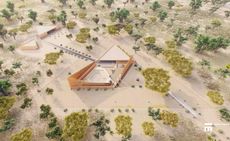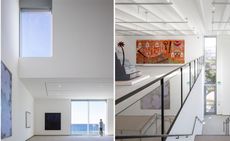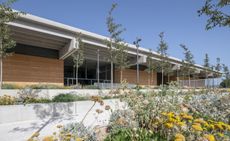A mirror to society: an Avraham Yasky survey at the Tel Aviv Museum of Art

Avraham Yasky was his generation’s most prolific architect. Early in his career he worked in the office of pioneering Israeli architect Arieh Sharon; later, he planned Rabin Square with Shimon Povsner, aged just 25. He went on to found the school of architecture at the Tel Aviv University and, in 1965, established Israel’s largest architectural firm with partners Joseph Sivan and Yitzhak Moore. MYS (Moore Yasky Sivan Architects) are responsible for many of Tel Aviv’s defining skyscrapers, including the envelope of the Azrieli Centre and the iconic beachfront Opera Tower, as well as numerous commercial buildings in the city centre, such as the Platinum, Alrov and AFI Towers.
Yasky made his name with his 1960s ’quarter-kilometre apartments’, working primarily with concrete – they were functional, monochromatic, modernist buildings. Later, his style would shift away from brutalism towards the possibilities of glass – a feature of many of the commercial projects he built – as well as more ornamental elements, seen in the shopping malls and pink-tiled towers that typify his later work.
Known for the flexibility and indifference with which he often faced stylistic and ethical issues, Yasky – who passed away in 2014, aged 87 – argued his success was simply down to good intuition and common sense. Now, the ideas behind his successes are to be explored through plans, photographs and other documentary materials relating to hundreds of Yasky projects, at a dynamic exhibition at the Tel Aviv Museum of Art. Commemorating and celebrating Yasky and his far-reaching legacy, the retrospective also contemplates the often troubled relationship between architecture and society – a relationship that is particularly complicated in a place that has seen such dramatic economic, social and political shifts as Israel in the course of the five decades of Yasky’s career.
If architecture is a mirror to society – as curator Dan Handel suggests—the exhibition poses another significant question to its audience: ’Is the story of the recent decades to be told as a sequence of intellectual, technological and material achievements – or perhaps as a tale about the gradual loss of an elusive, unquantifiable quality identified with Israel’s most influential architect?’ Time, as always, will tell.

Commemorating and celebrating Yasky and his far-reaching legacy, the retrospective also contemplates the often troubled relationship between architecture and society. Pictured: archive photograph from 1971

Yasky made his name with his 1960s ’quarter-kilometre apartments’, working primarily with concrete – they were functional, monochromatic, modernist buildings. Pictured: archive photograph from 1974

Later, his style would shift away from brutalism and concrete towards the possibilities of glass – a feature of many of the commercial projects he built. Pictured: archive image of the IBM Lobby from 1978

His later work utilised more ornamental elements, seen in the shopping malls and pink-tiled towers that typify his later work. Pictured: archive photograph from 1997

Known for the flexibility and indifference with which he often faced stylistic and ethical issues, Yasky – who passed away in 2014, aged 86 – argued his success was simply down to good intuition and common sense.
INFORMATION
’Yasky and Co: Israeli Architecture According to Avraham Yasky’ is on view from 16 April – 27 August. For more information, visit the Tel Aviv Museum of Art’s website
ADDRESS
Wallpaper* Newsletter
Receive our daily digest of inspiration, escapism and design stories from around the world direct to your inbox.
Tel Aviv Museum of Art
27 Shaul Hamelech Blvd
Tel Aviv
Charlotte Jansen is a journalist and the author of two books on photography, Girl on Girl (2017) and Photography Now (2021). She is commissioning editor at Elephant magazine and has written on contemporary art and culture for The Guardian, the Financial Times, ELLE, the British Journal of Photography, Frieze and Artsy. Jansen is also presenter of Dior Talks podcast series, The Female Gaze.
-
 Rick Owens’ new Moncler collaboration features a surreal ‘demountable mountain refuge’ inspired by Charlotte Perriand
Rick Owens’ new Moncler collaboration features a surreal ‘demountable mountain refuge’ inspired by Charlotte PerriandYour first look at Rick Owens’ latest Moncler collaboration, a mountain refuge designed alongside extreme-condition experts Hugh Broughton Architects and an accompanying clothing collection made for ‘hibernating’
By Jack Moss Published
-
 The new Ford Capri wants to tap a vein of Gen X nostalgia. Does it succeed?
The new Ford Capri wants to tap a vein of Gen X nostalgia. Does it succeed?We ask if the all-electric Ford Capri can capture the swagger of its much-loved but rather oafish predecessor
By Guy Bird Published
-
 Rug designer Sibylle de Tavernost’s homage to Fernand Léger
Rug designer Sibylle de Tavernost’s homage to Fernand LégerAbstract modern art, craft heritage and contemporary life fuse in Sibylle de Tavernost's new limited-edition rugs
By Harriet Thorpe Published
-
 New Jerusalem Academy of Music and Dance extension creates transparency with stone
New Jerusalem Academy of Music and Dance extension creates transparency with stoneThe Ari Kushner Building for the Jerusalem Academy of Music and Dance (JAMD) is completed, creating transparency with stone, and channelling chaos into its corridors
By Herbert Wright Published
-
 Mariam Issoufou Kamara to design Bët-bi museum in Senegal
Mariam Issoufou Kamara to design Bët-bi museum in SenegalMariam Issoufou Kamara, founder of Atelier Masōmī in Niger, has been selected by a jury to lead the design of the new Bët-bi museum in the Senegambia region of West Africa
By Hannah Silver Last updated
-
 The Museum of Contemporary Art San Diego unveils a bigger and brighter new space
The Museum of Contemporary Art San Diego unveils a bigger and brighter new spaceSelldorf Architects has welcomed the elements in to the Museum of Contemporary Art San Diego’s new light-filled design
By Hannah Silver Last updated
-
 Tehran’s Argo Factory complex reinvents brewery architecture for the arts
Tehran’s Argo Factory complex reinvents brewery architecture for the artsThe Argo Factory Contemporary Art Museum & Cultural Centre by Ahmadreza Schricker Architecture North (ASA North), housed in a redesigned brewery, becomes Tehran's first new arts hub in decades
By Ellie Stathaki Last updated
-
 Dubai welcomes the Museum of the Future
Dubai welcomes the Museum of the FutureKilla Design and the Dubai Future Foundation launch the Museum of the Future in Dubai, which opens its doors to the public today (22 February 2022)
By Ellie Stathaki Last updated
-
 Foster + Partners’ Narbo Via enriches cultural landscape in south of France
Foster + Partners’ Narbo Via enriches cultural landscape in south of FranceNarbo Via, a new museum by Foster + Partners, opens in Narbonne, France
By Ellie Stathaki Last updated
-
 The Design Museum and Snap bring extreme climate change to London
The Design Museum and Snap bring extreme climate change to LondonThe Design Museum and Snap’s new filter imagines an alternative reality
By Hannah Silver Last updated
-
 SANAA to resurrect Hexagon pavilion for Moscow’s Garage Museum extension
SANAA to resurrect Hexagon pavilion for Moscow’s Garage Museum extensionJapanese firm SANAA will overhaul the Hexagon pavilion, a 1920s Ivan Zholtovsky-designed structure in Gorky Park, for a Garage Museum extension
By Jessica Klingelfuss Last updated